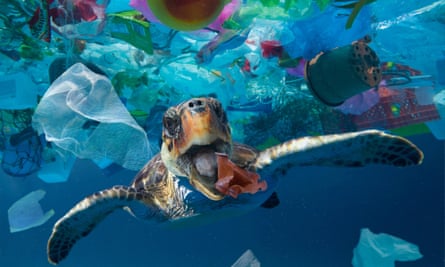Extract from The Guardian
Thirty times more plastic on ocean floor than surface, analysis suggests, but more trapped on land than sea.

At least 14m tonnes of plastic pieces less than 5mm wide are likely sitting at the bottom of the world’s oceans, according to an estimate based on new research.
Analysis of ocean sediments from as deep as 3km suggests there could be more than 30 times as much plastic at the bottom of the world’s ocean than there is floating at the surface.
Australia’s government science agency, CSIRO, gathered and analysed cores of the ocean floor taken at six remote sites about 300km off the country’s southern coast in the Great Australian Bight.
Researchers looked at 51 samples and found that after excluding the weight of the water, each gram of sediment contained an average of 1.26 microplastic pieces.
Microplastics are 5mm or less in diameter and are mostly the result of larger plastic items breaking apart into ever smaller pieces.
Stemming the tide of plastic entering the world’s waterways and ocean has emerged as a major international challenge.
Dr Denise Hardesty, a principal research scientist at CSIRO and a co-author of the research published in the journal Frontiers in Marine Science, told the Guardian that finding microplastic in such a remote location and at such depths “points to the ubiquity of plastics, no matter where you are in the world”.
“This means it’s throughout the water column. This gives us pause for thought about the world we live in and the impact of our consumer habits on what’s considered a most pristine place,” she said.
“We need to make sure the big blue is not a big trash pit. This is more evidence that we need to stop this at the source.”
The cores were drilled in March and April 2017 between 288km and 349km from the coast, at depths of between 1,655 metres and 3,016 metres.
Hardesty said it wasn’t possible to know how old the pieces of plastic were, or what sort of object they had once been part of.
But she said the shape of the pieces under a microscope suggested they were once consumer items.
For the study, the researchers extrapolated the amount of plastic found in their core samples and from research from other organisations to conclude as much as 14.4m tonnes of microplastic was now on the ocean floor globally.
While this may seem a large figure, Hardesty said it was small compared to the amount of plastics likely entering the ocean each year.
In September, a study estimated that in 2016 between 19m and 23m tonnes of plastic found its way into both rivers and ocean.
A previous study in the journal Science has estimated about 8.5m tonnes of plastic ends up in the oceans every year.
Another study has estimated there is 250,000 tonnes of plastic floating on the ocean surface.
In the latest paper, the authors note their estimate of the weight of microplastics on the ocean floor is between 34 and 57 times what may be at the surface.
Hardesty said there were imperfections in the estimates, but they were based on the best available information.
“It is useful to give people a sense of the scope and scale that we are talking about,” she said.
But she said the amount of plastic on the ocean floor was relatively small compared to all the plastics being released, suggesting the deep sea sediments were not currently a major resting place for plastics.
She said she believed the vast majority of plastics were actually accumulating on coastlines. “Much more is being trapped on land than at sea,” she said.
Dr Julia Reisser, a marine biologist at the University of Western Australia’s Oceans Institute, has been researching plastic pollution for 15 years.
“The marine science community has been really obsessed with finding out where the plastic is,” Reisser, who was not involved in the study, said.
Multiple scientific methods were needed to understand the potential impact of plastics on ocean wildlife. Larger plastic can entangle wildlife, while microplastics and even smaller pieces could be consumed by an array of species from plankton to whales.
She said the new study was an important contribution to global efforts, and hoped the deep-sea data from Australia could be combined with other efforts worldwide for future studies to get a more accurate picture.
Reisser has also founded a new organisation to investigate new plastics using seaweed as the basic material.
“I think the ultimate fate [of marine plastics] is the deep sea, but we are far from being at equilibrium,” she said.
“If we could travel a thousand years into the future, that plastic will have slowly fragmented and been removed from our coastline.”
Leaders from more than 70 countries signed a voluntary pledge in September to reverse biodiversity loss which included a goal to stop plastic entering the ocean by 2050.
Major countries that did not sign the pledge included the United States, Brazil, China, Russia, India and Australia.
No comments:
Post a Comment